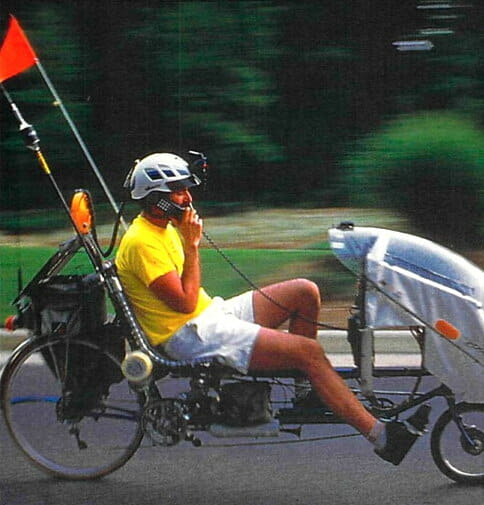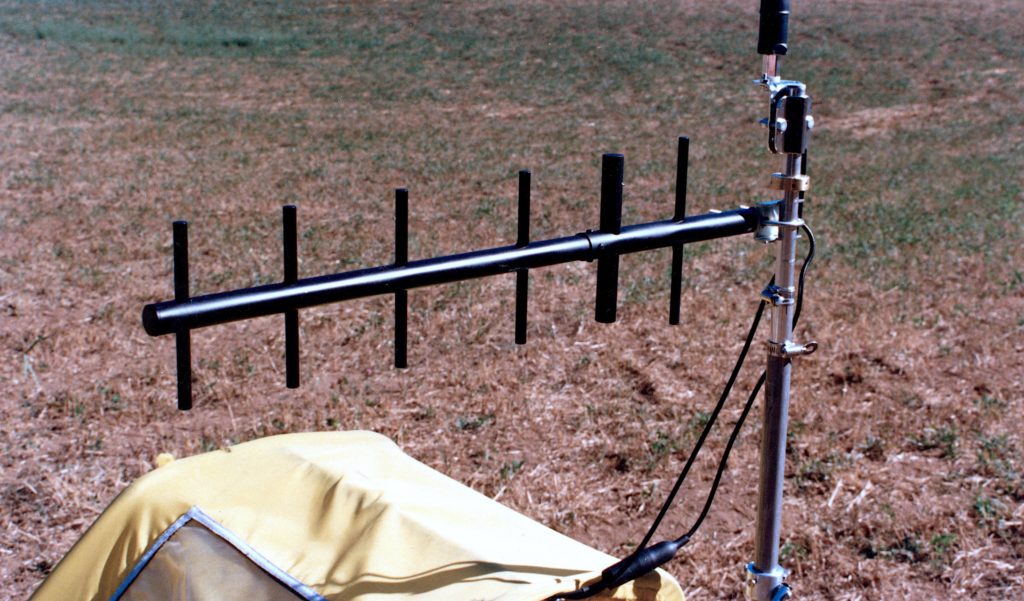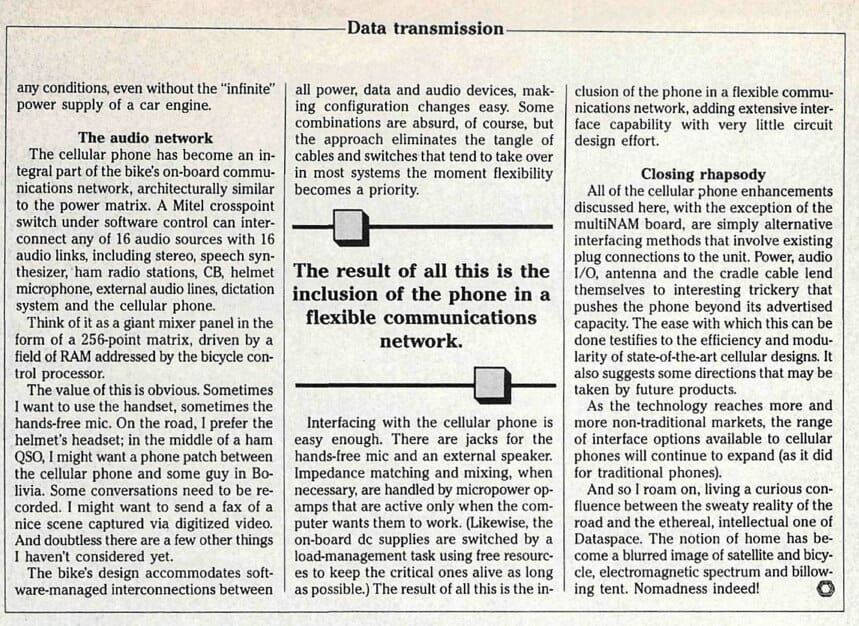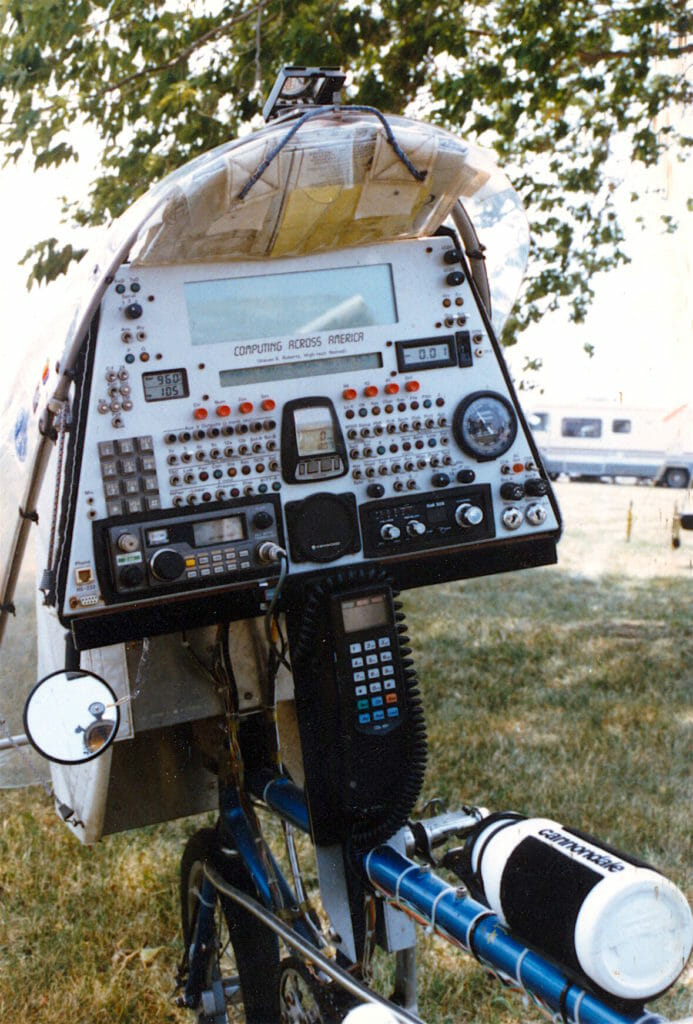
Taking Mobility to the Limit – Cellular Business
This article came at a pivotal time in both the evolution of the cellular industry and the design of my bike. Added to the Winnebiko II for testing, the Oki 491 phone did so well that it became fully integrated into BEHEMOTH… even to the point of deriving an RJ-11 phone line and distributing it around the bike for modem, fax, credit-card terminal, and answering machine. In 1988, cellular technology was radical stuff, and traveling with it was so complex (due to roaming issues) that a thick printed directory was necessary. Looking back at this is amusing in the age of Androids and iPhones… there is also a fun article about it in Telocator from about this same time.
 Data & cellular:
Data & cellular:
by Steven K. Roberts
Cellular Business
November, 1988
The author’s cellular-equipped “Winnebiko” operates as a roaming test bed for data transmission capabilities.
Roberts is a free-lance writer. He wrote this while bicycling through the Pacific Northwest. He expects to wander up and down the coast until spring, working on new bike systems.
Data transmission via cellular is an obvious marriage of the two technologies. Sending hard data from one location to another provides cellular subscribers with an additional application to what is already a productive tool.
The largest potential customer base for data transmission via cellular is the service industry — easily a hundred-billion-dollar industry. End-users benefiting most from this double-barreled tool would be the service personnel of hardware companies, people who make routine client calls for maintenance and repair purposes. Other industries that the cellular-data marriage would benefit are real estate and emergency services, as well as individual cellular subscribers who want to take their offices on the road.
This month, we take a look at a mobile office. It is not found in an automobile, as you might expect. Rather, it exists on a recumbent bicycle. Granted, the market for bicycles equipped with communications centers is extremely limited; no dealer is going to become rich approaching cyclists with this concept. However, this illustrates a dynamic application of cellular to other communications devices, even in the face of rather extreme environments.
Five years ago, Steve Roberts was writing documentation and sales literature for the Anatec division of Atlantic Richfield. Soon after, he decided he did not want to be tied to the traditional-type desk. He left his job, sold his house and built his new office on a recumbent bicycle, which he has pedaled across the United States ever since.
I see it every day — the longing, the envy, the faraway look. The dream is reflected in the eyes of the lunchtime business crowd as I park, sweaty, taking a break to inhale a kilocalorie or two. I see it in the faces that turn to catch a glimpse as I flash past office windows; I recognize it in the waves and thumbs-up from passing cars. It’s everywhere, for it’s a universal dream — the dream of freedom. And I am living it full time.
I have pedaled a 275-pound computerized bicycle 16,000 miles through the wilds of America. High-tech nomadics is my job, and it has been made possible by personal computers, information networks, a ham radio, solar power, a cellular phone, carbohydrates and a host of less-obvious supporting technologies.
The longing to travel is as much a part of the collective human spirit as the profit motive, but the two always have been considered more or less incompatible. Nevertheless, as information tools keep improving, so does our range of lifestyle options. For five years, I have been running a writing and consulting business from a solar-powered office on human-powered wheels.
This is the story of the cellular phone’s role in the “Winnebiko” system, along with the five enhancements that have fully integrated it into the on-board network of computers and audio components. First, a quick overview is in order.
The Winnebiko at a glance
The bike, a recumbent, has evolved continually since 1983 and now is undergoing radical modification in the form of satellite data links, a navigation system, CD-ROM mapping, a 350% increase in solar power capacity, an on-board antenna farm and more. It has become not only a robust work environment, but also a mobile test bed for the newest communications and computer technologies. Its value is incalculable, as the bike is the product of dozens of creative people and nearly 100 participating companies.
The bike’s five computers are networked together, allowing me to write, program and go on-line with remote computer services while riding. I type in binary at about 30 words per minute on a handlebar keyboard of eight buttons. There are more than three megabytes of on-board RAM, as well as a hard-disk-based file server that supports the various processors.
Communications gear includes ham radio equipment for all bands between 80 and 2 meters, with the addition this winter of an OSCAR Mode L satellite station (1.2 GHz uplink and 450MHz downlink). There is also a citizens band radio, a license-free AM broadcast station for information bulletins to passing drivers, a pair of packet TNCs and a 300MHz remote link with the security system. And, of course, there is an Oki 491 cellular phone, my essential conduit for business communications.
All of this — as well as lights, a security system, entertainment electronics and random accessories — is powered by the sun. Two Solarex SX-10 LITE photovoltaic panels are mounted on the bike itself, and three 20W units comprise the roof of the new trailer. A dedicated power-management processor steers incoming current either through a matrix of MOSFETs to the batteries that need it most or directly into a heavy load such as the OSCAR satellite uplink.
Mechanically, this custom-recumbent bicycle sports 54 speeds, disk brakes, under-seat steering, air horns and a trailer. Loaded for touring, the entire system weighs 275 pounds, is 12 feet long and has been known to exceed 50 mph down a mountain.
The role of cellular
The Oki phone was added in Norcross, GA, this past summer and is the most welcome addition in a long while. It simplifies my social interaction while passing through town, of course, but it also has solved three major problems of my nomadic business:
- For a nomad, telephone tag is even more of a curse than usual. I have spent weeks trying to reach clients, able to leave only my base office number near Louisville, KY.
- The quest for modular phone jacks always has been a big part of my lifestyle, especially on the eve of deadline when a story has to be uploaded.
- Ham radio, while a central social component of this nomadic adventure, has two major limitations: It’s not guaranteed to work all the time, and it doesn’t allow business traffic.
Cellular phone service addresses all three of these needs. It has become as much a part of the Computing Across America traveling circuits as the laptop computers and solar panels. Nevertheless, although cellular is convenient in the major service areas, I have discovered the problems of roaming. Where reciprocal agreements exist, the process is trivial; where they don’t, establishing an account can require anything from reading my credit card number over the air to physically visiting a service provider’s office.
The components of the model 491 are distributed over the length of the bicycle. The handset/cradle unit is mounted on the control console’s support column — protected from rain by a hook-and-loop fastener-type, waterproof fabric cover. The transceiver is on the other end of a 15-conductor cable, stowed safely under the rear solar panel along with some power-management electronics. The Larsen elevated-feed whip is behind that, mounted on the taillight bracket. The beam antenna is on the trailer.
Of course, a device as useful as a cellular telephone begs for interesting interfaces, especially in a setting like this. The system supports five major enhancements.
Data communications
My home is Dataspace, with GEnie the primary network vendor. Wandering full time would be a lonely and frustrating process were it not for the continuity of the computer networks. It is here that I get my mail, interact with the base office, communicate with publishers and cavort with on-line friends. Of course, I can do it through pay phones with an acoustic coupler when necessary, but much of my life has been spent tracking down modular jacks for that daily sign-on ritual. This often involves taking over a host’s phone line for an hour or more, frantically trying to catch up with overflowing electronic “in” and “in deeper” baskets.
With the Spectrum Cellular Span modem, I can sign on from campgrounds, roadside rest breaks or even while pedaling. Unpackaged, the unit is simply a circuit board inserted between the cradle and TRU, with an RS-232 link to the bike’s computer network. Power is derived from the phone itself, and CMOS circuitry keeps battery drain to a minimum.
The Span is happiest when talking with a Bridge, the corresponding modem designed for installation at the fixed end of the data link. Some MTSOs have installed them for general customer use, allowing any “digital” cellular phone user to connect, then redial out the back door to a host system. A few computer networks have installed them in key nodes. Whatever the architecture, the Span-Bridge combination performs all the forward error correction and housekeeping necessary to clean up RF noise problems and the dropouts caused by hand-offs.
Incidentally, the Span works fine even without being connected to a corresponding Bridge. In this mode, it acts simply like a normal modem, subject to the hand-off problem. The key here is to sign on from the periphery of a service area, where the chances of being swapped to a neighboring cell are minimal.
Antenna enhancement
The whip antennas that have evolved for the cellular phone market are quite effective, as much at home on a bicycle as on the roof of a car. At 850MHz, not much ground plane is necessary. The Larsen elevated-feed whip mounted on my bicycle has performed flawlessly.
An omnidirectional whip does have disadvantages, especially when traveling through weak-signal areas. The fringe of a market may be all I ever see; the density of motorized traffic usually discourages me from venturing too far into the madness. As a result, my cellular service with the whip often is spotty except during the day or two prior to my closest approach to a city. (My travel patterns are the opposite of those exhibited by the typical business customer.)
Until the RSAs are widespread, there is only one solution to the problem of finding cellular service in the boonies — a beam antenna. My bike now sports a 6-element Larsen yagi, which provides 10 dB of gain with a very tight radiation pattern. Depending on conditions, this extends the phone’s range by a factor of five or more, increasing my coverage so much that cities more than one hundred miles apart often have no service gap in between.
The beam has to be used with discretion. A directional antenna is counterproductive within a normal service area. The phone is always connected to the whip, and if the signal-strength display is zero, I stop, swap a coax connector, raise the mast and rotate the yagi until the meter reads maximum. By the way, I’m not the only one doing this. On one island I know of, outrageous local phone charges have led many residents to acquire cellular phones and attic-mounted beam antennas, with which they connect to a nearby metropolitan area for all calls.

If you have roamed nationally, you know that the cellular industry is in its turbulent adolescence. The process of wandering the United States with a cellular phone still is not a simple one of making calls freely and watching the bills roll in from afar.
There have been problems with roamer fraud. Vendors change their policies. And the whole system is complicated by confusion between wireline and non-wireline carriers. It’s a mess, to put it simply, and significant consumer market penetration of this technology will never occur until these constraints are removed.
There is at least one interesting solution to the problem. I don’t have the exact numbers yet, but somewhere between five and 10 cellular service agreements between the major players ultimately could take care of roaming within the bulk of the U.S. market areas. The problem, of course, is that once your phone has been programmed with, say, a Southwestern Bell number assignment module (NAM), then it is defined forever as a Southwestern Bell phone. Right?
Not quite. The NAM is just a ROM chip, and it turns out that any number of them can be wired into a simple bus structure and enabled through the “chip select” pins. Practically, this translates into an external circuit board with a NAM-selector switch connected into the body of the TRU by a ribbon cable. There is a chance that this violates some of the phone’s RF shielding. (In the case of the Oki phone, an elegant silver braid lines the TRU cover to prevent noise leakage.) Nevertheless, it seems to work, and doubtless there is a market for a cellular phone that contains four to eight NAM sockets and a provision for easy keyboard selection of the phone number.
Incidentally, there is an easier way to implement this for those who don’t want to mess with logic design. Simply remote the NAM socket with a 16-pin DIP cable, male on one end and female on the other. Now you can swap devices without phone surgery.
The Solar telephone
Life on a bicycle imposes a variety of serious constraints unfamiliar to those who travel by car. Almost every device made for automotive installation treats electrical power as an inexhaustible resource. This includes cellular phones. Amplifiers left operating in the standby mode, inefficient regulators, display backlights… I constantly have to deal with such things when adapting power-hungry automotive appliances to the bike.
The cellular phone generally was well-designed in this regard, because it is a transportable unit with a 2Ah or 4Ah battery. But cellular phones still pump out 3W of RF, and there’s no escaping the problem of short battery life. Thus, I have married the phone to the bike’s solar-power system, replacing its normal battery-management circuitry with my own.
The job of the power-management processor is to monitor all the Solarex solar panels and auxiliary current sources (including an ac charger and emergency 12V “jumper” input from a car). Based on measured battery levels and a RAM disk file of usage history, power is switched from the active sources to the eight major batteries on the bike, one of which is owned by the cellular phone.
This same system provides for battery swapping through the MOSFET array. If the phone battery dies, I can borrow power from the lighting system, computer, ham radio or anywhere else using a simple software command. The net effect is uninterrupted performance under almost any conditions, even without the “infinite” power supply of a car engine.
The audio network
The cellular phone has become an integral part of the bike’s on-board communications network, architecturally similar to the power matrix. A Mitel crosspoint switch under software control can interconnect any of 16 audio sources with 16 audio sinks, including stereo, speech synthesizer, ham radio stations, CB, helmet microphone, external audio lines, dictation system and the cellular phone.
Think of it as a giant mixer panel in the form of a 256-point matrix, driven by a field of RAM addressed by the bicycle control processor.
The value of this is obvious. Sometimes I want to use the handset, sometimes the hands-free mic. On the road, I prefer the helmet’s headset; in the middle of a ham QSO, I might want a phone patch between the cellular phone and some guy in Bolivia. Some conversations need to be recorded. I might want to send a fax of a nice scene captured via digitized video. And doubtless there are a few other things I haven’t considered yet.
The bike’s design accommodates software-managed interconnections between Data transmission all power, data and audio devices, making configuration changes easy. Some combinations are absurd, of course, but the approach eliminates the tangle of cables and switches that tend to take over in most systems the moment flexibility becomes a priority.
Interfacing with the cellular phone is easy enough. There are jacks for the hands-free mic and an external speaker. Impedance matching and mixing, when necessary, are handled by micropower op-amps that are active only when the computer wants them to work. (Likewise, the on-board DC supplies are switched by a load-management task using free resources to keep the critical ones alive as long as possible.) The result of all this is the inclusion of the phone in a flexible communications network, adding extensive interface capability with very little circuit design effort.
Closing rhapsody
All of the cellular phone enhancements discussed here, with the exception of the multiNAM board, are simply alternative interfacing methods that involve existing plug connections to the unit. Power, audio I/O, antenna and the cradle cable lend themselves to interesting trickery that pushes the phone beyond its advertised capacity. The ease with which this can be done testifies to the efficiency and modularity of state-of-the-art cellular designs. It also suggests some directions that may be taken by future products.
As the technology reaches more and more non-traditional markets, the range of interface options available to cellular phones will continue to expand (as it did for traditional phones).
And so I roam on, living a curious confluence between the sweaty reality of the road and the ethereal, intellectual one of Dataspace. The notion of home has become a blurred image of satellite and bicycle, electromagnetic spectrum and billowing tent. Nomadness indeed!









You must be logged in to post a comment.